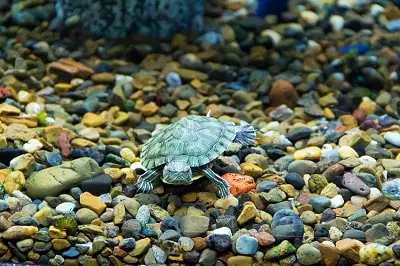The key to being the best turtle parent is understanding all about your pet. Box turtles, for instance, are unique turtles being that they are terrestrial animals. They spend most of their lives on land, unlike their counterparts, which makes you wonder whether they can swim.
Box turtles can swim if they have to but they’re not as skilled as other aquatic species. They look clumsy doing it and would rather stay on land; hence, it is advisable to provide shallow water. You will only find them swimming in special circumstances where it is the last resort.
We will discuss the box turtle’s ability to thrive in the water and all the main aspects you may wish to know. Read on as we go deeper into these creatures’ lives to help you better comprehend your pet.

How Well Can Box Turtles Swim?
Given the common ancestry, some people believe that all turtle species can swim. They all have similar adaptive swimming parts and are biologically modified to survive in water, but what is the box turtle’s case?
Box turtles can swim but not as well as other turtle species. Generally, all the species can swim, but some are better at it than others. They usually have short feet, and each has individual toes, denying them the swimming skills seen in other aquatic turtles like the Red-Eared Sliders and Cooters. Although they aren’t adept at it, box turtles spend some time in the water and swim when they need to. Fortunately, they get all they need from the land, and, have, over the years, evolved to live ashore. In contrast, some species like the Coahuilan turtles live mostly in water.
Other aquatic turtles that are prolific swimmers have webbed feet and streamlined bodies. However, the box turtles are not that skilled, and most are rather clumsy while at it, and their single toes only make it worse. Therefore, they cannot swim effortlessly like other turtles without the special features. You need to provide more dry land than water to reduce the stress of swimming most of the time.
Generally, a box turtle will swim when it has to; that is when it’s a matter of life and death. When in the wild, they swim to escape predators or cross water when looking for food. On the other hand, they will swim in captivity when you place them in a tank. Swimming to them only comes in handy when they need to survive, but they get all their needs on land in real life.
A little-known fact is that box turtles are more likely to drown than other species. They can easily suffocate when the water is too deep and wide, and they fail to get ashore on time. Since they are not avid swimmers, they tire easily and soon give up trying to stay afloat. Moreover, they cannot hold their breaths for long; hence, are not great at staying underwater either. It is best to check that the turtle’s feet can touch the tank or container’s base and its head can stay above the water when you provide some soaking water,
How Long Can Box Turtles Swim?
Another pressing question about the boxes is how long they can swim. You may guess that since they are not prolific swimmers, they would rather not spend a lot of time in the water; we conducted more research to find out more.
Since they are not adept swimmers, box turtles can only take a few minutes in the water. They cannot stay for long because the more time they spend underwater, the more the chances of drowning. They easily tire and can drown since they find it tasking to hold their breath for long. They also lack the adaptive features seen with other aquatic animals, which makes it harder for them to propel their bodies forward. The maximum time that box turtles can stay afloat or navigate in water is 20-30 minutes, and any more only increases their drowning chances.
You will notice that the box turtles are clever enough to swim on the water surface but won’t go underwater. Considering it is hard for them to paddle and float, being feet below the surface will only make it worse. Instead, they choose to have their heads out of the water while they swim to replenish their oxygen levels. In most cases, box turtles swim when they need to get across ponds or creeks to find mates, food, or escape predators. Thus, you will hardly find them underwater or trying to cross giant water bodies.
The turtles are also pretty slow when in the water, navigating at less than six mph and only increasing the speed to about 20 mph when trying to escape predators. The species’ affinity to water also depends on its natural habitat. For instance, you are more likely to see the Florida species in water than the Desert turtles. They frequently get in the water since their homes are usually damp and marshy. Similarly, they are better swimmers and are less likely to drown.
Can Box Turtle Swim Underwater?
The box turtle looks exactly like the common tortoise, with features allowing it to roam the land. Although they aren’t adept at swimming like their Red-Eared Sliders and other aquatic species, we need to establish what happens when the water is too deep for them.
You cannot find the box turtle underwater because they are not skilled at swimming. However, a particular aquatic box turtle species called the Coahuilian turtles can be found below water surfaces and in shallow waters. Most box turtles can’t swim underwater for extended periods because they need to stay in water for some time then come to the shores for more air and rest. If you put the box turtle below the water surface, it will stay put for a few minutes but tire quickly and emerge to the surface where it feels more comfortable.
These turtles cannot swim well in deep bodies or below the surface; hence, they need shallow waters. Otherwise, they will drown. You may need to place the turtle in low water levels where you are certain that it won’t submerge and drown. When the water is too deep, the box turtles would rather sink and rest for a while before coming back to the surface to try reaching a shallow end. On the contrary, turtles like Cooters would normally swim under deep waters.
Another important factor to consider is the right amount of water for your turtle. Since the reptiles are lazy swimmers and love feeding on insects found on the water surface, you can ensure that the water levels in the tank don’t go beyond half an inch of the turtle’s shell. This way, the turtle will easily navigate and feed, eventually leading a healthy and happy life.
Read more: Do Turtles Sleep Underwater
Do Box Turtles Need Water?
Every reptile requires water as part of the essential needs. It is vital for the turtle’s health, and your pet can hardly go without it. Therefore, we went on to find out how much water your box turtle needs.
First, box turtles need water to digest food. They also need it to soak their bodies to dehydrate because enough wetness means that their shells will remain glossy, sleek, and attractive. Additionally, water cleanses foreign particles from the animal’s eyes and further washes dirt from its body. For convenience, a flat and shallow container with a few inches of water will suffice for the turtle; however, you will need to clean the dish and replenish the water frequently.
It is advisable not to use any available water for your turtle’s consumption. Preferably, use freshwater, but if you have to provide tap water, ensure that it is de-chlorinated as such water contains unsafe chemicals. Although chlorine doesn’t pose serious harm to your pet, it will make the reptile’s shell appear white and irritate their eyes. The best way to go is to avoid it and instead use distilled water.
A few liters a week is enough, and it is affordable since you won’t be buying the water daily. The right amount of water for your turtle depends on its original environment. Turtles that previously lived in hot and dry environments can withstand a little water, while those from humid regions need more. Regardless, it is best to soak the turtle and moisten its enclosure at least once a day for better health.
Finally
Box turtles are unique, being that they are terrestrial hence spend most of their lives on land. Unlike a common belief, all the species can swim, although not as well as other aquatic creatures. They are clumsy because they lack the adaptive features they need to navigate in water. Therefore, it is rare to find them swimming underwater since they don’t spend much time in the water.
It is easy for them to get tired, and there are reported drowning cases. When in the wild, they only swim when they have to and if they need to get across water bodies. You can always provide water for them to soak and drink to keep hydrated for health reasons, but careful that it isn’t too deep for them to drown.
Read more:


![How Long Can Turtles Go Without Water? [Truth Revealed] Turtles Go Without Water](https://coolpetsadvice.com/wp-content/uploads/2021/05/Turtles-Without-Water-400.jpg)





